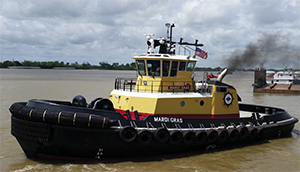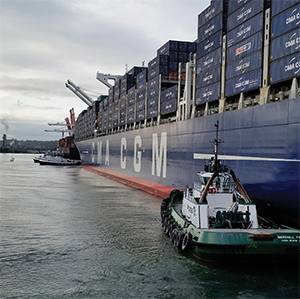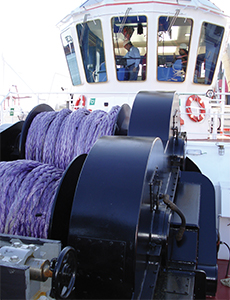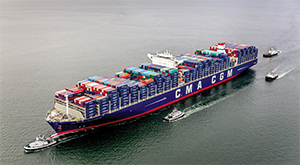Winches and deck equipment have long been a conservative corner of the tugboat industry, but that’s changing as tugs become more powerful and lines get stronger to handle the ever-larger ships visiting American ports.
Winch makers have responded to the challenge by introducing heavier-duty units with larger drums and increased braking power. Meanwhile, staples, bitts, foundations and other components of the deck system have been reinforced to handle increasing loads.
For example, McAllister Towing expects its new 100-by-40-foot tugboats currently under construction to generate 82 metric tons of bollard pull. Yet certain components of the vessels must withstand far greater loads. Each tug’s Markey DESF-48-100 winch will be loaded with 3.25-inch line with 1 million pounds of breaking strength.
“It’s amazing,” said Marty Costa, McAllister’s engineering manager. “You’ve got to build everything on that boat that the line is connected to, to the breaking strength of the line, so it’s a challenge.”
Consider the bow staple, which must absorb the forces the line is exerting on it. The staple on McAllister’s new 6,770-hp tugs weighs 40,000 pounds and is made of 24-inch pipe 2.5 inches thick. The staple also extends some 10 feet below deck.
“That’s a design consideration. And the winch foundation itself — you don’t want it getting pulled off deck, so you’ve got to design a winch to be able to take forces, and designers have to plan the foundation to plant this on so that it is not going to tear off,” Costa said.
Brandon Durar, president of JonRie Intertech, a Manahawkin, N.J., maker of winches and deck equipment, saw these changes coming years ago.
“What was done 10 or 15 years ago is not the answer today,” he said, describing the increasing force and loads placed on tugs and deck equipment. “We need to address those issues, and how do we address them? With heavy-duty equipment.”
 |
|
Crescent Towing’s Mardi Gras has a JonRie Container Master winch for added strength. |
|
Courtesy JonRie Intertech |
The company recently introduced a new Container Master winch series specifically designed to handle large containerships.
“(These) winches are of heavy-duty design to deal with increased loading due to increased sail area of larger containerships coming in the near future,” Durar said in a news release announcing the winch line. “The new winch design has increased braking capability and rope capacity to deal with the large forces produced by the massive ships.”
Crescent Towing’s new z-drive tug Mardi Gras is one of the first vessels outfitted with a Container Master winch. The winch aboard this 5,500-hp tug can apply 350,000 pounds of brake tension and has a drum that can hold 550 feet of 9-inch synthetic line.
Seabulk’s highly anticipated rotor tugs expected out later this year also will have JonRie Container Master winches on deck.
JonRie isn’t the only winch maker that’s bulked up its equipment to meet market demands. Scott Kreis, Markey Machinery’s vice president of sales, notes the size of the tugs, their power and the size of the high-performance lines are driving this evolution. Safety is another consideration.
“Especially in the U.S., there is a real concentration on crew safety and that drives some consideration of winch arrangement and choice,” he said. “We’ve had to step up … not only the size of the winch, but the pulling power, brake holding capacity and winch controls.”
These changes also have required winch makers to work with naval architects early in a new tugboat’s design stage to ensure the deck system is appropriate. Gone are the days when customers could open a catalog and say, “I want that one, send it to me in blue.”
 |
|
The four Foss tugs deployed to assist CMA CGM Benjamin Franklin during its visit to Seattle in February have super bitts rated for 100 tons or more. |
|
Courtesy Don Wilson/Foss Maritime |
“We want to be involved early on to make sure the winch is robust enough and placed on deck properly so the geometry doesn’t overload the winch,” Kreis said.
Advances in synthetic line are another driver in the need for more robust deck equipment. Synthetic lines have become significantly stronger than just a few years ago, but these lines also are extremely slippery, Costa said. This requires bigger staples, giving the line more area to make contact to reduce friction.
“With the new ropes and larger ships arriving in the ports, we are seeing extreme line tensions on the (tugboats) and at the end of the day, if they keep going up in horsepower, we need to look at many other aspects,” Durar said. “One is the staple on the front of the tugs.”
Indeed, companies are experimenting with staple location to improve performance. On Mardi Gras and sister vessel Arkansas, for instance, the staple is placed 6.5 feet farther aft to provide increased steering forces while in indirect mode and to improve overall stability.
“Talking to (the captains), it’s been a big improvement to the tug itself,” said Larry Ohler, Crescent Towing’s port engineer in New Orleans. “It has a better pivot point. … It gave us 30 percent more steering force than when we had the staple up forward.”
One of Crescent’s captains suggested the idea, having seen it work well at other tugboat companies. Ohler said Crescent researched the idea and has been pleased with the results. The new staple location will be standard on its new tugs.
Crescent, which works in New Orleans, Savannah, Ga., and Mobile, Ala., typically handles Suezmax, Aframax and “a few baby Capesize bulkers,” according to company Vice President Keith Kettenring. These massive vessels once seen as cutting-edge now seem almost quaint compared to the 18,000- and 20,000-TEU megaships dubbed “neo-Panamax.” These new vessels are so named because the Panama Canal was expanded to handle them.
These megaships are already starting to explore U.S. ports. In February, the 1,300-foot CMA CGM Benjamin Franklin steamed into Seattle with thousands of containers piled six and seven high across its massive deck. The vessel is one of the 20 largest ships in the world and among the largest to ever to visit a U.S. terminal. Foss Maritime tugs escorted the ship in and out of port.
 |
|
Markey’s DESDF-48WF electric hawser winch features dual drums and 760 horsepower to help tug operators stay in control of big ships. |
|
Courtesy Markey Machinery |
Mike Stone, Foss’ regional operations manager for the Pacific Northwest, said the company knew for almost a year that the vessel would be visiting Seattle. Foss worked with the Puget Sound Pilots to plan for a safe escort of the 18,000-TEU ship.
Foss used four tugs in the operation: the 5,000-hp Henry Foss and Wedell Foss, the 6,250-hp Marshall Foss, and the 8,000-hp Lindsey Foss. Stone said the vessels have super bitts rated for 100 tons or better and other robust deck equipment.
“There is comfort in knowing that,” he said. “That is something we come up against in a ship like Benjamin Franklin and the stuff we were asked early on: Exactly where and how we would make up, what if the weather is above a certain point on the Beaufort scale, what are the bitts and chocks and stuff rated for.”
Benjamin Franklin probably won’t make regular stops in Seattle, at least initially. But that port and others across the U.S. are expecting larger ships to visit more regularly, particularly in the 13,500-TEU range. This trend likely will accelerate now that the new Panama Canal locks have opened.
“Years ago, the standard used to be 6,000 (TEU),” Stone said. “Then in the last couple of years, we saw an increase and a bump up to 8,000 TEU. Then once we hit 10,000 TEU, it was like, ‘Goodness, these are getting big.’”
Durar said the newly designed deck equipment will make sure tugs can handle the increased tonnage as ships continue to get bigger. These advances also reflect customers’ demands to adapt with the market.
“Phones are evolving and so are winches, which used to be a pretty conservative industry,” Durar said. “Now we have customers saying, ‘What is the latest?’”

